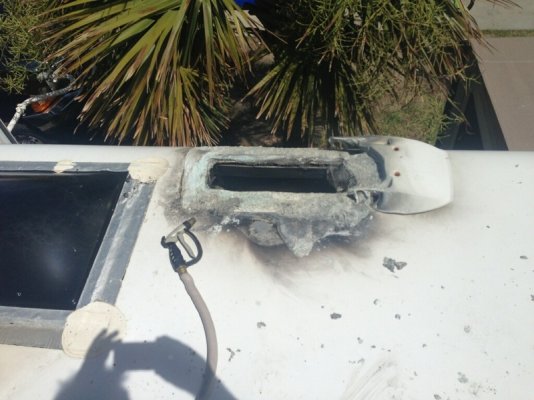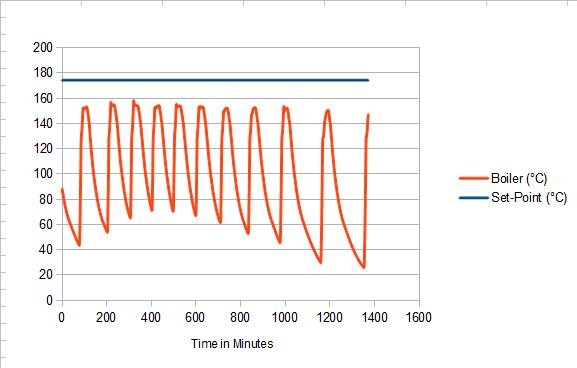You are using an out of date browser. It may not display this or other websites correctly.
You should upgrade or use an alternative browser.
You should upgrade or use an alternative browser.
Fridge: How Level is "enough"?
- Thread starter Gary RV_Wizard
- Start date
The friendliest place on the web for anyone with an RV or an interest in RVing!
If you have answers, please help by responding to the unanswered posts.
If you have answers, please help by responding to the unanswered posts.
The appeal of the 18 cu ft Samsung is that it is a counter depth model that is 4" higher than NoCold 1200 but fits the cutout for a 1200 for width and depth. With the doors removed the 1200 and the Samsung are 23" deep and both went out and in through our coach's door so installation including removing the 1200 took about 3 hours. The only mod to get them through the door was moving the copilot seat and a rubber seal on the door.
After the Samsung was installed I pulled it out of the wall and altered the base to satisfy myself by lowering the refrigerator about 3". Materials to do that were $35.00.
Ned unless you travel to Indiana most quotes I saw to have an Amish unit shipped and installed were in the $1600-2000 range.
After the Samsung was installed I pulled it out of the wall and altered the base to satisfy myself by lowering the refrigerator about 3". Materials to do that were $35.00.
Ned unless you travel to Indiana most quotes I saw to have an Amish unit shipped and installed were in the $1600-2000 range.
toastergirl
Well-known member
Okay, so for those of us who are RV newbies, most of this technical stuff is pretty confusing, but I am trying to learn. If I understood the post correctly, a lot of RV fridges need to be kept level, and if you leave them on and drive up or down hills or park somewhere where you are not level, it can cause problems up to and including catching your RV on fire. Is that right?
And your friend invented something to stop that from happening?
Sorry for my lack of knowledge, but I am still trying to figure all this stuff out. If I got the jist of the post, that sounds like a pretty awesome invention!
And your friend invented something to stop that from happening?
Sorry for my lack of knowledge, but I am still trying to figure all this stuff out. If I got the jist of the post, that sounds like a pretty awesome invention!
Molaker
Well-known member
Mostly, you've got it, but leaving them on while driving is not a problem even when going up or down hills. When moving there is enough motion and vibration to keep the coolant circulation going and not cause blockage and possible dangerous heat build-up.toastergirl said:Okay, so for those of us who are RV newbies, most of this technical stuff is pretty confusing, but I am trying to learn. If I understood the post correctly, a lot of RV fridges need to be kept level, and if you leave them on and drive up or down hills or park somewhere where you are not level, it can cause problems up to and including catching your RV on fire. Is that right?
And your friend invented something to stop that from happening?
Sorry for my lack of knowledge, but I am still trying to figure all this stuff out. If I got the jist of the post, that sounds like a pretty awesome invention!
hes4all
Well-known member
Jeff said:The appeal of the 18 cu ft Samsung is that it is a counter depth model that is 4" higher than NoCold 1200 but fits the cutout for a 1200 for width and depth.
Jeff, you say that the Samsung in only 4" taller? I always thought it was 7"? Boy, this is really got me thinking now.
The repair for my 1200 is about $150 for the board and $80 for the ARP. I do the work because I work cheap.
Not to bad changing the cooling unit out , just to let you guys know. My son and I changed out the cooling unit to the Amish one and it took about 6 hours including a few calm down breaks!
And Gary, our 1200 works great now. The only time I have ever gone above 5 was in Leadville this year @ 10,000 ft elevation. Had to set it on 6.
But I do like the idea of extra room of the Samsung too. What do I do?
Fix the Norcold then go from there. Can't sell it the way it is and I don't do that to people.
Thanks guys!
Gary RV_Wizard
Site Team
Okay, so for those of us who are RV newbies, most of this technical stuff is pretty confusing, but I am trying to learn. If I understood the post correctly, a lot of RV fridges need to be kept level, and if you leave them on and drive up or down hills or park somewhere where you are not level, it can cause problems up to and including catching your RV on fire. Is that right?
And your friend invented something to stop that from happening?
You got it pretty well. ALL absorption RV fridges need to be very close to level to operate correctly. RV fridge manufacturers say that being a little off-level, or intermittent off-level while driving, is no problem. My friend Paul's research indicates this is not entirely true and that internal damage happens in those situations, albeit slowly in most cases. Paul believes the ultimate result of that internal damage is failure and possibly a fire when it fails. His invention prevents that damage.
The subjective part of the debate is how much damage and how long does it take to accumulate to the danger point. And that, of course, varies with the the individual fridge and how it gets used.
carson
Well-known member
In other words, for people without the ARP, it would be advisable to turn the fridge OFF when anticipating a lengthy climb and descent until they are back on level ground. Not a big deal to do.
Gary RV_Wizard
Site Team
And when you stop for lunch or pull into a fuel station or...
Molaker
Well-known member
Maybe I'll just get a block of ice. 
Gary RV_Wizard
Site Team
Like most everyone else, I never worried about the effects of uphill/downhill on the fridge, nor was I very concerned about brief stops where I was off-level. Watching the ARP demo, the thing that astounded me most was how quickly the boiler temperature shoots up once the tilt exceeds the critical value. What I had envisioned as a slow process that could be tolerated for short periods turned out to be more like a rocket launch, where it transitions from nothing to major effect in under a minute. Couple that with the scientific fact that the sodium chromate corrosion inhibitor is heat sensitive and you have, I think, adequate cause to be concerned. Clearly the owner can manage this by turning off the fridge when at risk, but it sure is nice to have a device watching for the symptoms and automatically handling it for us. That way I get to enjoy RVing more.
Molaker
Well-known member
Perhaps what is needed is a "level" detector that senses the attitude and shuts the fridge off when too far off. In fact, with all the hoopla and bad history, I don't know why it's not built in.
jje1960
Well-known member
- Joined
- Nov 11, 2007
- Posts
- 1,556
While not having anything to do with leveling.... This picture is from a fridge fire that was very scary ( I was there and put the fire out) not something I wish to deal with again! Our neighbor last summer was awaken by a big 'boom' and toxic fumes that quickly consumed the Endeavor MH. End of the ordeal, they got out alright, we got the fire out before the fire trucks arrived. Flames were already 4' when we started, not a nice situation. RV fridges are wonderful comforts, however sometimes things go wrong.
Attachments
Gary RV_Wizard
Site Team
I think the reason that fridges don't have a built-in level sensor is that it is not a simple task to get it right. If they put in a simple sensor, basically one that shut down at 2 or 3 degrees of tilt, they would be shutting the fridge off unnecessarily. The spec for "level" is 3 degrees in one direction, but 6 degrees in another. Plus, they would probably want to include a time parameter as well as angle (though the ARP demo suggests the time is very short). If they just put in a tilt sensor that shut down at, say, 6 degrees, then some people would have failures at less than that value and would rightly complain that the tilt sensor didn't do its job. But probably more to the point, the fridge makers appear to believe that most fridges survive off-level operation in normal use, so no extra-cost sensor is necessary.
Atwood's new helium based RV fridge does have a level sensor as one of its features. However, in an independent test the fridge was tilted far to the side and the sensor did not activate, so its not clear how it works. For more on the Atwood fridge, see the series of videos from FRVTS. Here is their video that shows the Atwood tilt test: http://www.youtube.com/watch?v=3YysfHocCQI
Atwood's new helium based RV fridge does have a level sensor as one of its features. However, in an independent test the fridge was tilted far to the side and the sensor did not activate, so its not clear how it works. For more on the Atwood fridge, see the series of videos from FRVTS. Here is their video that shows the Atwood tilt test: http://www.youtube.com/watch?v=3YysfHocCQI
For one data point, our motorhome is off by about 1/2 a bubble both side to side and fore and aft. I collected the boiler temperatures over a 24 hour period using the ARP and the graph shows normal cycling with no tendency to overheat. The ARP set point was 174?C and the maximum boiler temperature was 158?C during that time.
Edit: Fixed temp units
Edit: Fixed temp units
Attachments
Gary RV_Wizard
Site Team
Cycling nicely! While the data collection cabvle isn't a standard part of the ARP package, it is kind of fun to watch how the fridge cooling unit operates.
Ned, why does the chart say the temperatures are inNed said:For one data point, our motorhome is off by about 1/2 a bubble both side to side and fore and aft. I collected the boiler temperatures over a 24 hour period using the ARP and the graph shows normal cycling with no tendency to overheat. The ARP set point was 174?F and the maximum boiler temperature was 158?F during that time.
Just Lou said:Ned, why does the chart say the temperatures are inCentigradeCelsius?
Because they are. I fixed the message units.
Ernie n Tara
Well-known member
Level sensors are relatively expensive components. With the associated controller, it could add as much as $70-80 to the manufacturing cost. A flow sensor based system would probably be less expensive and more effective.
Ernie
Ernie


